Akasa M.2 SSD Enclosures Reviewed: Giving Spare Drives a New Lease of Life
by Ganesh T S on September 22, 2021 8:00 AM EST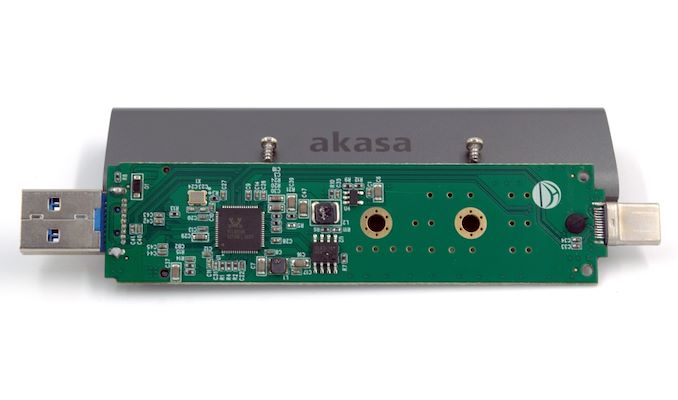
The internal storage device market segment has seen rapid evolution over the last decade after the introduction of flash-based disk drives. Beginning with 2.5-inch SSDs in early 2010s, the market moved to mSATA units while the SATA-to-NVMe transition started to gather steam. Fast forward to the present, and we find M.2 2280 PCIe 3.0 x4 NVMe SSDs the de-facto standard even for entry-level PCs.
PCIe 4.0 NVMe SSDs are slowly making its way into the market, and many users are finding themselves with spare M.2 SSDs. A common re-purposing method has been to place the SSD in a USB enclosure. Having reviewed multiple storage bridges and enclosures, we have found that companies typically target this market segment with a new product every couple of years (based on the internal drive characteristics going out of fashion / latest USB generation).
Akasa is one of the few manufacturers to possess a SSD enclosure lineup catering to almost all possible scenarios in this market segment. Earlier this year, the company sampled their lineup of M.2 SSD enclosures lineup - the Akasa AK-ENU3M2-02 (SATA), AK-ENU3M2-03 (NVMe), and the AK-ENU3M2-04 (SATA / NVMe) - to put through our storage bridges evaluation routine. All three enclosures come with a USB 3.2 Gen 2 (10 Gbps) host interface. This review takes a look at the performance of each enclosure, their unique aspects, and usage scenarios.
Introduction
SSDs have grown both in storage capacity as well as speeds over the last decade, thanks to rapid advancements in flash technology (including the advent of 3D NAND and NVMe). Starting from 2.5-inch disk drives barely able to saturate the SATA III (6 Gbps) interface in the early 2010s, we now have gumstick- and palm-sized drives with PCIe 4.0 support capable of sustaining more than 7000 MBps (56 Gbps).
These SSDs have also formed the base platform for portable SSDs. Traditionally, such drives have fallen into one of the six categories below, depending on the performance profile and internal components. Recently, we have seen direct flash-to-USB controllers across all but the highest performance tier listed here.
- 2.5GBps+ class: Thunderbolt SSDs with PCIe 3.0 x4 NVMe drives
- 2GBps+ class: USB 3.2 Gen 2x2 SSDs with PCIe 3.0 x4 NVMe drives
- 1GBps+ class: USB 3.2 Gen 2 SSDs with PCIe 3.0 (x4 or x2) NVMe drives
- 500MBps+ class: USB 3.2 Gen 2 SSDs with SATA drives
- 400MBps+ class: USB 3.2 Gen 1 SSDs with SATA drives
- Sub-400MBps+ class: USB 3.2 Gen 1 flash drives with direct flash-to-USB controllers
In addition to portable SSDs, this type of segmentation is also applicable to storage enclosures. Since the mid-2010s, we have seen a regular stream of SSD enclosures hit the market, catering to 2.5-inch, mSATA, and M.2 form-factors.
This review takes a look at three Akasa M.2 SSD enclosures catering to PC users attempting to give new life to their spare SSDs. Irrespective of the M.2 SSD type, Akasa believes that one of the following three enclosures is bound to satisfy the user requirements.
- Akasa AK-ENU3M2-02 : M.2 SATA enclosure with a Type-C female host interface
- Akasa AK-ENU3M2-03 : M.2 NVMe enclosure with a Type-C female host interface
- Akasa AK-ENU3M2-04 : M.2 SATA / NVMe enclosure with Type-A and Type-C male host interfaces
The AK-ENU3M2-04 is the most interesting of the lot. In addition to supporting both SATA and NVMe SSDs, it also sports Type-A and Type-C male connectors. There is no cable to carry around / misplace, and the dual interface ensures that it is compatible with a wide range of systems. In addition, the tool-less design ensures that swapping SSDs is quick and painless. Overall, the AK-ENU3M2-04 ticks all the boxes for becoming part of the arsenal of computer support personnel.
The table below presents a comparative view of the specifications of the different storage bridges presented in this review.
| Comparative Storage Bridges Configuration | ||
| Aspect | ||
| Downstream Port | 1x PCIe 3.0 x2 (M.2 NVMe) 1x SATA III (M.2) |
1x PCIe 3.0 x2 (M.2 NVMe) 1x SATA III (M.2) |
| Upstream Port | USB 3.2 Gen 2 Type-C USB 3.2 Gen 2 Type-A |
USB 3.2 Gen 2 Type-C USB 3.2 Gen 2 Type-A |
| Bridge Chip | Realtek RTL9210B-CG | Realtek RTL9210B-CG |
| Power | Bus Powered | Bus Powered |
| Use Case | M.2 2242 / 2260 / 2280 SATA / NVMe SSD aluminum enclosure DIY 1GBps-class portable SSD with a USB flash drive-like form-factor Type-A and Type-C male ports integrated |
M.2 2242 / 2260 / 2280 SATA / NVMe SSD aluminum enclosure DIY 1GBps-class portable SSD with a USB flash drive-like form-factor Type-A and Type-C male ports integrated |
| Physical Dimensions | 130 mm x 26.5 mm x 12 mm | 130 mm x 26.5 mm x 12 mm |
| Weight | 36 grams (without SSD) | 36 grams (without SSD) |
| Cable | N/A | N/A |
| S.M.A.R.T Passthrough | Yes | Yes |
| UASP Support | Yes | Yes |
| TRIM Passthrough | Yes | Yes |
| Hardware Encryption | SSD-dependent | SSD-dependent |
| Evaluated Storage | SK hynix P31 PCIe 3.0 x4 NVMe SSD SK hynix 128L 3D TLC |
Western Digital WD Red SA500 SATA SSD SanDisk BiCS 3 64L 3D TLC |
| Price | GBP 40 | GBP 40 |
| Review Link | Akasa AK-ENU3M2-04 Review | Akasa AK-ENU3M2-04 Review |
The storage enclosures use chipsets from different vendors - the AK-ENU3M2-02 SATA enclosures uses the VIA Labs VL716, while the AK-ENU3M2-03 NVMe one uses the ASMedia ASM2362. The SATA / NVMe dual support in the AK-ENU3M2-04 is enabled by the Realtek RTL9210B-CG. Other differences include the bundling of thermal pads in the NVMe-only AK-ENU3M2-03, and the inclusion of both Type-C and Type-A cables with the SATA-only AK-ENU3M2-02. The NVMe-only AK-ENU3M2-03 includes only a Type-C to Type-C cable. The AK-ENU3M2-04, as mentioned previously, does not need a cable since Type-A and Type-C male ports are already integrated on the board.
The galleries below bring out the industrial design of the enclosures as well as the package contents.
The Akasa AK-ENU3M2-02 is a M.2 SATA SSD aluminum enclosure with a USB 3.2 Gen 2 (10Gbps) Type-C interface. Since SATA SSDs do not go beyond 560 MBps, such enclosures have minimal thermal solution requirements. The enclosure supports both B-key and B+M-key SSDs with lengths from 30mm up to 80mm. Type-C to Type-C, and Type-C to Type-A cables are supplied. Disassembling the enclosure involves removing four screws at either end. A screwdriver is also included in the package. Spare side panels are supplied along with the package, as shown in the gallery above. The VIA Labs VL716 bridge chip can also be seen in the underside of the mainboard. The SSD is mounted using a pre-installed screw mechanism.
The Akasa AK-ENU3M2-03 is a M.2 PCIe NVMe SSD brushed aluminum enclosure with a USB 3.2 Gen 2 (10Gbps) Type-C interface. Since SSDs in such enclosures can reach speeds of more than 1 GBps, thermal pads are required to complement the metal enclosure. SSDs installed in the AK-ENU3M2-03 operate in PCIe 3.0 x2 mode. The enclosure supports both B-key and B+M-key SSDs with lengths from 30mm up to 80mm. A single Type-C to Type-C cable is supplied. Disassembling the enclosure involves removing four screws at either end. A screwdriver is also bundled in the package. A single spare panel with the Type-C port cut out is provided along with the thermal pads, as shown in the gallery below.
The main board is a single-sided one, with the ASMedia ASM2362 bridge chip placed between the Type-C port and the M.2 slot. The SSD is mounted using a pre-installed screw mechanism. The enclosure could potentially be made smaller by moving the bridge chip to the underside of the board. One thermal pad is meant for mounting on the bridge chip, and another on the SSD. The SSD pad is sized for a M.2 2230 unit, which unfortunately doesn't provide an optimal thermal solution for other sizes. Inserting the mainboard back into the enclosure is slightly messy, as the pad tends to break up into chunks easily upon sliding over the inner metal surface. On the positive side, this implies good contact allowing the enclosure to draw heat away from the thermal pad in an effective manner.
The Akasa AK-ENU3M2-04 is the unique solution in the lot being considered today. While there are plenty of M.2 SATA and NVMe to USB-C enclosures in the market, the AK-ENU3M2-04 sports a host of unique features:
- Support for both M.2 SATA and M.2 NVMe SSDs, with the bridge chip being able to dynamically configure its downstream interface based on the installed SSD.
- Inclusion of both USB 3.2 Gen 2 Type-C and Type-A male connectors, enabling a thumb-drive form-factor.
- Completely tool-free installation.
The enclosure supports M.2 SSDs (B-key and B+M-key) ranging in lengths from 42mm to 80mm (M.2 2230 is not supported, unlike the other two enclosures above). The package includes the main unit and a carrying pouch. A spare side panel (that is slid out to access the mainboard) and a spare rubber retention peg are also included, as shown in the gallery below.
While the enclosure itself is fully aluminum, plastic caps are placed at either end to protect the USB connectors. Accessing the mainboard involves sliding out the side panel (directions embossed on the panel) and pulling out the board using the Type-A connector. The M.2 retention peg is preinstalled for a M.2 2280 SSD. Moving it to the 2260 or 2242 holes doesn't involve dismounting the board, but we dismounted it anyway to get a view of the bridge chip on the other side. The Realtek RTL9210B-CG bridge chip runs the show in this enclosure. The product ticks multiple boxes, but one of the missing aspects is the thermal solution. Our evaluation process looks into the side-effects of this, as detailed further down in the review.
M.2 SATA SSD enclosures are evaluated with the Western Digital WD Red SA500 1TB SSD installed, while M.2 NVMe ones use the SK hynix Gold P31 1TB NVMe SSD.
Using the same SSD across different enclosures allows us to make apples-to-apples comparisons related to the thermal solution and other aspects. All the enclosures support S.M.A.R.T passthrough and TRIM functionality, as shown in the CrystalDiskInfo screenshots below.
| S.M.A.R.T Passthrough - CrystalDiskInfo | |
 |
 |
Prior to looking at the benchmark numbers, power consumption, and thermal solution effectiveness of the different storage enclosures, a description of the testbed setup and evaluation methodology is provided.
Testbed Setup and Evaluation Methodology
Direct-attached storage devices (including storage enclosures) are evaluated using the Quartz Canyon NUC (essentially, the Xeon / ECC version of the Ghost Canyon NUC) configured with 2x 16GB DDR4-2667 ECC SODIMMs and a PCIe 3.0 x4 NVMe SSD - the IM2P33E8 1TB from ADATA.
The most attractive aspect of the Quartz Canyon NUC is the presence of two PCIe slots (electrically, x16 and x4) for add-in cards. In the absence of a discrete GPU - for which there is no need in a DAS testbed - both slots are available. In fact, we also added a spare SanDisk Extreme PRO M.2 NVMe SSD to the CPU direct-attached M.2 22110 slot in the baseboard in order to avoid DMI bottlenecks when evaluating Thunderbolt 3 devices. This still allows for two add-in cards operating at x8 (x16 electrical) and x4 (x4 electrical). Since the Quartz Canyon NUC doesn't have a native USB 3.2 Gen 2x2 port, Silverstone's SST-ECU06 add-in card was installed in the x4 slot. All non-Thunderbolt devices are tested using the Type-C port enabled by the SST-ECU06.
The specifications of the testbed are summarized in the table below:
| The 2021 AnandTech DAS Testbed Configuration | |
| System | Intel Quartz Canyon NUC9vXQNX |
| CPU | Intel Xeon E-2286M |
| Memory | ADATA Industrial AD4B3200716G22 32 GB (2x 16GB) DDR4-3200 ECC @ 22-22-22-52 |
| OS Drive | ADATA Industrial IM2P33E8 NVMe 1TB |
| Secondary Drive | SanDisk Extreme PRO M.2 NVMe 3D SSD 1TB |
| Add-on Card | SilverStone Tek SST-ECU06 USB 3.2 Gen 2x2 Type-C Host |
| OS | Windows 10 Enterprise x64 (21H1) |
| Thanks to ADATA, Intel, and SilverStone Tek for the build components | |
The testbed hardware is only one segment of the evaluation. Over the last few years, the typical direct-attached storage workloads for memory cards have also evolved. High bit-rate 4K videos at 60fps have become quite common, and 8K videos are starting to make an appearance. Game install sizes have also grown steadily even in portable game consoles, thanks to high resolution textures and artwork. Keeping these in mind, our evaluation scheme for portable SSDs and UFDs involves multiple workloads which are described in detail in the corresponding sections.
- Synthetic workloads using CrystalDiskMark and ATTO
- Real-world access traces using PCMark 10's storage benchmark
- Custom robocopy workloads reflective of typical DAS usage
- Sequential write stress test
A comprehensive overview of the performance of the different Akasa enclosures is provided in the following sections. Prior to providing concluding remarks, we have some observations on the power efficiency aspect also.



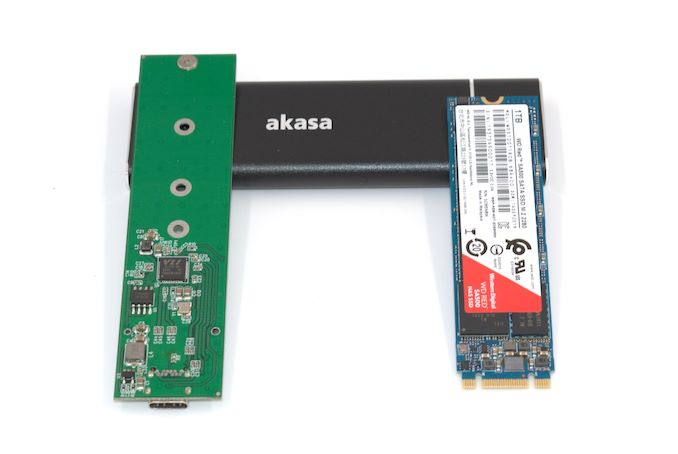





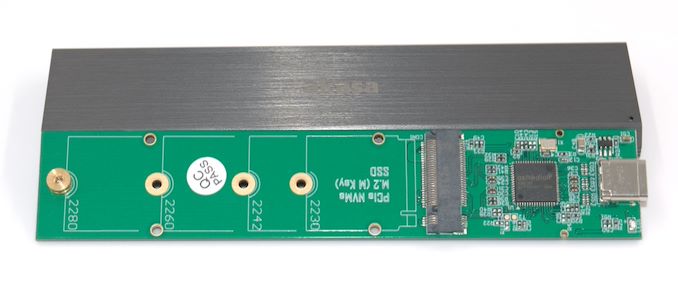






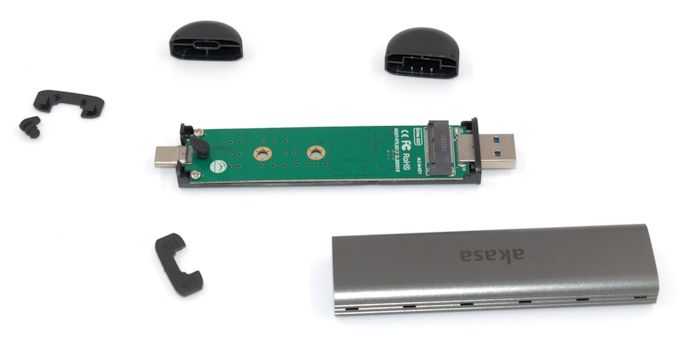






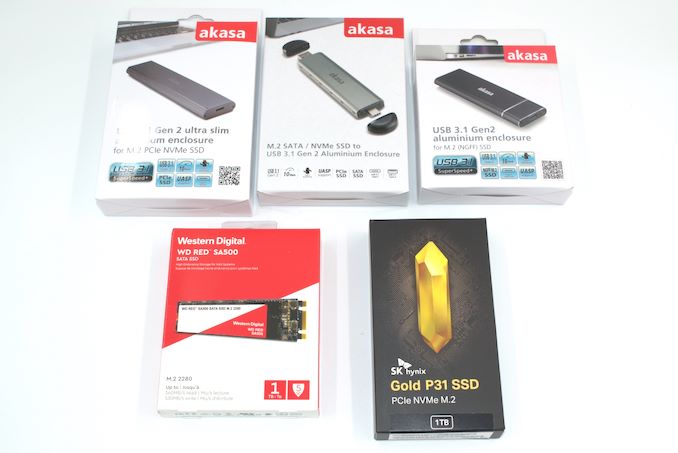









15 Comments
View All Comments
ganeshts - Wednesday, September 22, 2021 - link
The Turing fanless case we reviewed last year is still doing great in deployment, and I don't think we have reviewed any Akasa gear after that. The storage bridges we reviewed in this article came in early last year, and the multi-protocol unit has been 'abused' greatly across multiple systems - has been working great for the last couple of months. The other two bridges were subject to only our evaluation process with a single host port, and that in itself is quite rigorous (multiple portable SSDs / storage bridges have experiences dropouts under heavy traffic, but no such issues with the Akasa bridges).Tomatotech - Thursday, September 23, 2021 - link
Thankfully I’ve successfully avoided buying any SATA m.2 drives. There must be people out there who were forced by circumstances into buying them, but I haven’t met any. Are there AnandTech readers out there who had to buy them?anad0commenter - Friday, September 24, 2021 - link
Does any of these work with the Plextor m6e AHCI PCIe m.2 SSD? It's one of the weirdest SSDs out there, which came out before NVMe became popular. And for the life of me, I can't find an enclosure that will work with it. SATA m.2 enclosures don't seem to be compatible.Tomatotech - Sunday, September 26, 2021 - link
I think you want an AHCI adaptor. It’s a little dongle about an inch wide that goes between the SSD and the m.2 socket. I’m not sure if we’re talking about the same thing here, but Apple used a weird type of SSD for several years 2013-2015ish. So there’s a bit of a market for adaptors to retrofit the Mac laptops so that they can use modern NVMe drives. I have 2 of these adaptors in my Mac laptops.The problem is the adaptors that are available are intended to let a modern nvme ssd fit into Apple’s weird socket (it was designed before the nvme standard was nailed down). What you’re after is an adaptor to let your weird drive fit into a modern socket. Good luck searching. I haven’t had much luck finding adaptors to let me re-use my surplus Apple OEM m.2(ish) drives as a portable ssd.
(Don’t want to sell my Apple OEM drives as some OS bootrom upgrades prefer the original drive in place.). TBH at this point in time I regard any non-NVMe ssd as a lost cause and effectively worthless, at least in the smaller sizes.
anad0commenter - Tuesday, September 28, 2021 - link
The adaptor was a good idea, but it turns out that it's only for macbooks, which use a 12+16 pin notch. So when I put the Plextor SSD on one side, the other side of the adaptor will not go into a standard m.2 slot which has a notch after 5 pins.There's a USB3.0 enclosure on ebay that claims it's AHCI NGFF compatible. But it costs $70!! Not sure if it's worth the risk to find out of it works with the Plextor....